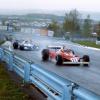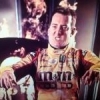Posted 13 August 2003 - 13:46
August 13,
1946, DNQing, Grand Prix driver, Divina Galica was born in Bushey Heath England.
1950, Glenn "Fireball" Roberts' first NASCAR win comes in only his third race, at Hillsboro, North Carolina.
1971, CART driver, Patrick Carpentier was born in Quebec, Canada.
1972, At the Austrian GP, The field was unchanged from the German GP, except for the reappearance of the Connew, driven by Migault. Pole position was taken by World Championship leader Emerson Fittipaldi with Ferrari's Clay Regazzoni alongside him on the front row. Jackie Stewart shared the second row in his Tyrrell with Peter Revson (McLaren) while Brabham's Carlos Reutemann was on the third row with Chris Amon (Matra). The top 10 was completed by Tim Schenken (Surtees), Denny Hulme (McLaren), Howden Ganley (BRM) and Jacky Ickx (Ferrari). It was a bad weekend for Williams with Henri Pescarolo having a huge crash and destroying one of the team's March chassis (having demolished the new Williams F1 car at Brands Hatch a fortnight earlier).
At the start Stewart went into the lead, ahead of Regazzoni, Fittipaldi and a fast-starting Hulme. Reutemann, Revson and Amon gave chase. Regazzoni immediately started having fuel-feed problems but managed to keep Fittipaldi behind him for four laps before losing second place by which time Stewart was three seconds clear at the front. Regazzoni pitted soon afterwards. Fittipaldi chased after Stewart and gradually closed the gap and so the two were running together. On lap 24 Fittipaldi took the lead. By that point Hulme had closed up to them and he was able to pass Stewart for second place on lap 27. Stewart continued to drop back down through the order, losing third to Peterson and fourth to Revson, soon afterwards Peterson ran into trouble with fuel feed problems and dropped away, leaving Revson in third place. The battle for the lead continued all the way to the flag but Fittipaldi was able to hold on to win by just over a second. The victory gave Fittipaldi a lead in the championship of 25 points with only three races remaining. Denny Hulme would need to win all three without Emerson scoring a point to beat the young Brazilian to the title.
1977, Bobby Isaac died. Through a 15-year career, Isaac won 37 NASCAR Winston Cup Series races which ranks him 15th on the all-time wins list. In 1970, Isaac topped the field to win the NASCAR Winston Cup Series championship. Also in 1970, he set what was then a world closed-course speed record when he ran 201.104 mph at Talladega (Ala.) Superspeedway. Isaac's 50 pole positions ranks him sixth on the all-time list and seventh on the all-time list of laps led with 13,229. Isaac set a single-season record on pole positions won with 20 in 1969. Isaac died in 1977 of a heart attack, following a race at Hickory (N.C.) Speedway. In 1979, Isaac was inducted in the National Motorsports Press Association's Hall of Fame at Darlington (S.C.) Raceway. In 1996, Isaac was inducted into the International Motorsports Hall of Fame in Talladega, Ala.
1978, Osterreichring again, The race began with rain threatening and while Peterson took the lead Andretti did not get away well and Reutemann took second with Andretti third ahead of Scheckter, Laffite, Fittipaldi, Hunt and the rest. Andretti tried to go around the outside of Reutemann later in the lap and the two cars touched wheels, the Lotus spinning into the barriers. Reutemann then lost second place to Scheckter and Depailler (the latter having overtaken Hunt, Fittipaldi and Laffite in the course of the first lap).
Soon afterwards heavy rain began to fall and on the fourth lap Scheckter crashed out, colliding with Andretti's abandoned Lotus. Reutemann also spun and before the race was red-flagged Watson was up to third with Laffite fourth and Pironi fifth. Jabouille had been fourth but he spun just before the race was stopped ad dropped back down the order.
A new grid was formed up, based on the finishing positions in the first part of the race, and so Peterson was on pole with Depailler second, Watson third, Laffite fourth with the top 10 being completed by Pironi, Lauda, Hunt, Clay Regazzoni (Shadow), Daly, Alan Jones (Williams), Keke Rosberg (Theodore Wolf) and Villeneuve.
At the restart Depailler got away fastest while Watson stalled. This caused Riccardo Patrese (Arrows) and Harald Ertl (Ensign) to collide. At the front Peterson quickly overtook Scheckter but Jones spun off and Daly collided with Hunt and the McLaren driver spun into the barriers. The order at the end of the first lap was therefore Peterson ahead of Depailler, Lauda, Laffite and Daly.
Peterson remained in control as the track dried, while Reutemann charged up the order to third place. When the front-runners began pitting for slick tires Reutemann stayed out and his teammate Villeneuve moved into second place. When they too stopped for tires Peterson went back into the lead and stayed there all the way to the flag with Depailler second and Villeneuve third. Hans Stuck (Shadow) was fourth but crashed out while Daly looked to be on course for fourth place until he spun and was then given outside assistance to restart. He was black-flagged. This left Fittipaldi fourth with Laffite fifth (on aggregate) and Brambilla (fifth on the road but sixth on aggregate).
1989, NASCAR Winston Cup driver, Tim Richmmond dies of complications from AIDS at age 34. Although his NASCAR career lasted just seven years, Richmond's on-track performances made an impression on the competition. In 1986, the flamboyant driver won seven races, more than any other driver, and finished a career-high third in the NASCAR Winston Cup points race. Richmond started just eight races in 1987, winning two races, one pole position, tallying three top-five and four top-10 finishes.
1989, Hungarian GP, Qualifying was always important in Hungary and so Riccardo Patrese was delighted when he took pole position in his Williams-Renault, beating Ayrton Senna's McLaren and the remarkable Alex Caffi in his Dallara (Pirelli producing better and better qualifying tires). Thierry Boutsen was fourth with Alain Prost (McLaren) fifth. Gerhard Berger was sixth ahead of Sandro Nannini's Benetton, Stefano Modena's Brabham (on Pirellis), Derek Warwick's Arrows and Pierluigi Martini's Minardi (another Pirelli runner). Nigel Mansell was a disconsolate 12th on the grid.
The start was vital but Patrese did not make a mistake and stayed ahead of Senna. Caffi was third but it was soon clear that the Pirelli runners would struggle in the race and he was soon overtaken by Berger, Prost and the flying Mansell. The order at the front was static but Mansell chipped away and moved gradually up to third and when Patrese went out with puncture radiator Mansell found himself second behind Senna. On lap 58 the pair came up to pass backmarker Stefan Johansson in his Onyx. The Swede was having gearbox trouble and just as the leaders arrived behind him the problem struck again and the Onyx slowed unexpectedly. Senna dived right but had lost momentum and Mansell, seeing his chance, went to the right of Senna. Mansell had the lead and went on to win. Senna was second with Boutsen third and Prost fourth. Eddie Cheever (Arrows) finished fifth with Nelson Piquet (Lotus) picking up a point for sixth place.
1995, Clifford Allison died in practice crash for a NASCAR Busch Grand National race in Michigan. Clifford Allison was Bobby's youngest son and Davey's little brother. Clifford was a up and coming driver on the Grand National circuit. And was showing promise. Clifford raced the late model division, ARCA, All-Pro series
1995, Again at the Hungaroring, Damon Hill took his fourth consecutive pole with Coulthard right behind him. Schumacher was third, but a long way off the pole time, despite pushing over the limit on several occasions - notably when he indulged in a high-speed 360-degree spin on the pit straight. Ferrari was in trouble with Alesi crashing very heavily on Friday - a little desperation seemed to have been the cause. Berger qualified fourth and Alesi managed sixth, the pair split by Hakkinen's McLaren, a brave lap, but evidence that the McLaren-Mercedes combination was finally on the move - or so it seemed. For once Mika was not just battling Jordans.
In the race Hill simply drove away from his rivals, led by Coulthard and Schumacher. Hakkinen's Mercedes V10 went kaputt early on and the only overtaking manoeuvre was when David made a mistake under pressure from Michael and the Benetton driver blasted through.
Schumacher chased after Hill - who had built a 15-second lead. The pair pitted at the same time but this time Benetton's normally-impressive pitwork went badly wrong. In the back of the garage the refuelling machine suddenly begun to fountain petrol. A sealed union in the pressurised piping had not been properly connected. Michael's fuel was not in his car, it was on the floor of the garage. This sort of thing is very scary because fuel vapour can be explosively dangerous. Mercifully, the mess was cleaned up without a spark.
Whatever the case Schumacher did not have enough fuel and by the time he did he was half a minute behind Hill. During the next pit stop sequence the pair had a tussle but Schumacher soon had to pit again. At the third stop Hill was too far ahead to have to worry about Schumacher. Three laps from home, Michael's bad afternoon came to a miserable end when his engine suffered an electrical failure. Would Michael would have caught Damon if he had not had the fuel rig problem? We will never know.
Further back there was some good battling between the Ferraris, Jordans, McLarens, Ligiers, Johnny Herbert's Benetton and Heinz-Harald Frentzen's Sauber. Gradually they began to drop out: Alesi with a spark plug failure; Blundell with a fuel pressure problem; Brundle with a blown engine; Irvine with clutch failure and - on the last lap when he was running third - Barrichello with electrical trouble. He was passed by Berger, Herbert, Frentzen and Panis - all covered by 1.2secs - within sight of the chequered flag.


















